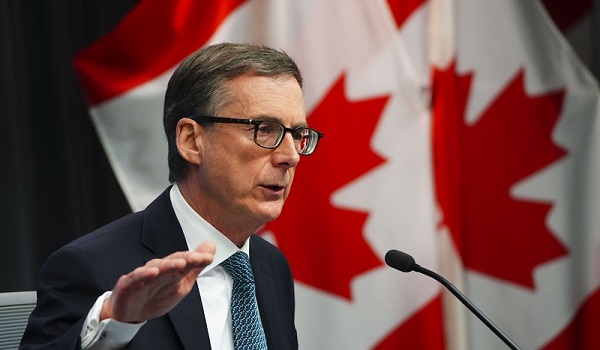Bank of Canada expected to ease monetary policy with oversized rate cut this week
The Bank of Canada is widely expected to accelerate monetary-policy easing this week with an oversized interest-rate cut in response to weak economic growth and concerns that inflation could get stuck below the central bank’s target.
In recent weeks, analysts and investors have coalesced around the idea that the bank will lower its policy interest rate by half a percentage point to 3.75 per cent on Oct. 23. That would follow three consecutive quarter-point cuts, and hasten the bank’s efforts to get borrowing costs back to a more normal level.
Rate decisions are never a sure thing, and some Bay Street analysts think the bank will stick to its guns with another quarter-point move. But the case for a larger cut has strengthened.
“Once you see everything kind of in line, there are good reasons to move quickly and come down,” said Paul Beaudry, a former deputy governor at the Bank of Canada and an economics professor at the University of British Columbia.
The annual rate of inflation hit the central bank’s 2-per-cent target in August for the first time since 2021, then fell to 1.6 per cent in September. Canada’s economic growth is sluggish, unemployment has risen sharply and consumers and businesses remain downbeat.
In short, most economists think the current level of interest rates – which are at least a percentage point above what the bank considers to be neutral – are too restrictive for this point in the economic cycle, where inflation is no longer a menace and recession risks are real.
“There are certain costs of moving too quickly. You don’t want to look erratic. But the case for bringing it down is really there,” Mr. Beaudry, who retired from the central bank last year, said in an interview.
At the end of last week, interest-rate swap markets put the odds of a half-point cut on Wednesday above 90 per cent, according to LSEG data. Meanwhile, 19 out of 29 analysts polled by Reuters are betting on this outcome.
Bank of Canada Governor Tiff Macklem has said in recent appearances that a half-point cut is on the table if inflation and economic growth come in lower than expected. On both counts, the data have undershot the bank’s forecast.
The quarterly Monetary Policy Report from July expected GDP to grow at an annualized rate of 2.8 per cent in the third quarter. The latest Statistics Canada data suggest the actual growth rate is somewhere between 1 per cent and 1.5 per cent.
And there are headwinds on the horizon, including a wall of expensive mortgage resets over the next two years, and new federal caps on temporary immigration, which will slow population growth – one of the few things that has driven overall economic growth in recent years.
Inflation, meanwhile, seems to have returned to a normal level ahead of schedule. The latest decline in headline inflation was driven largely by falling oil prices, which the bank tends to play down, given their volatility. But measures of core inflation, which strip out volatile prices, are getting close to 2 per cent, and price pressures are becoming far less widespread across a broad range of goods and services.
The retreat of inflation from a four-decade high in 2022 has been a global phenomenon. But inflation has declined particularly fast in Canada, which is more sensitive to high interest rates than many other countries. That’s the result of high household debt and mortgages that reset every few years. If consumers have to spend more servicing debt, they have less to spend on other things, weighing on demand and curbing price pressures.
“Canada really stands out, not just relative to the U.S., but really relative to broader developed markets as being the economy where you’ve seen a significant rise in the unemployment rate and inflation that has not only come back down significantly, but we think is also at risk of actually undershooting the Bank of Canada’s target next year,” Allison Boxer, an economist with Pacific Investment Management Company (PIMCO), said in an interview.
If the Bank of Canada picks up the pace of cutting this week, that would likely put it on a different trajectory from the U.S. Federal Reserve. The Fed kicked off its own easing cycle last month with a half-point cut. But stronger-than-expected inflation, jobs and spending data in recent weeks have led markets to price in a slower pace of easing from the Fed going forward.
Because currency exchange rates are influenced by relative interest-rate levels in different countries, the Canadian dollar has weakened notably against the U.S. currency over the past month, as bond markets have priced in different paths for the BoC and the Fed.
Sarah Ying, head of foreign-exchange strategy at CIBC Capital Markets, said that the Bank of Canada is unlikely to be constrained by a weakening Canadian dollar. Theoretically, this can push up inflation, as imported goods cost more. But most currency moves would only add a fraction of a percentage point to inflation, Ms. Ying said.
“The currency will move, but it’s not going to move by a cataclysmic amount,” she said in an interview. “And even in the most hawkish case for the Fed, or the most extreme BoC-Fed divergence, we still don’t add much to core inflation.”
For many Canadians, the key question is whether larger rate cuts this week or in the future will bring down mortgage rates. Here, there may be some disappointment.
Interest rates on fixed-rate mortgages are based on longer-term bond yields, rather than on the overnight rate controlled directly by the Bank of Canada. Bond yields have already come down considerably in expectation of further rate cuts, which means much of the BoC’s cutting cycle has already been priced into fixed-rate mortgages.
That said, if the Bank of Canada continues to make dovish noises and markets start expecting a lower end point for the policy rate in this easing cycle, that could pull down bond yields and mortgage rates.
“Of course, there are global dynamics, what’s happening in the U.S.,” said Ms. Boxer of PIMCO. “But to the extent we see a more aggressive BoC cutting cycle, you would expect broader intermediate rates to benefit from that as
This article was first reported by The Globe and Mail













